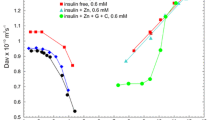Abstract
A fast and effective model for predicting the salt and pH dependent properties of protein complexes is presented. It is based on the formal charge parameter sets of ionizable groups and applied in conjunction with the finite difference Poisson-Boltzmann (FDPB) method to calculate the electrostatic interactions. All simulations were performed on the native 2Zn insulin and its fast-acting mutants such as B9D (B9Ser→Asp), B9E (B9Aer→Glu), B9EB10D (B9Ser→ Glu, B10His→Asp), and B10D (B10His→Asp). The salt and pH dependent properties of these dimers were analyzed from the aspect of electrostatic interaction, and the theoretical basis of the fast-acting behavior of these mutants was explained. It is found that the results agree well with experimental observations.
Similar content being viewed by others
References
Nakamura, H., Roles of electrostatic interaction in proteins, Q. Rev. Biophys., 1996, 29: 1.
Honig, B., Nicholls, A., Classical electrostatics in biology and chemistry, Science, 1995, 268: 1144.
Antosiewicz, J., McCammon, J. A., Gilson, M. K., Prediction of pH-dependent properties of proteins, J. Mol. Biol., 1994, 238: 415.
Mehloer, E. L., Self-consistent, free energy based approximation to calculate pH dependent electrostatic effects in proteins, J. Phys. Chem., 1996, 100: 16006.
Sitkoff, D., Sharp, K. A., Honig, B., Accurate calculation of hydration free energy using macroscopic solvent models, J. Phys. Chem., 1994, 98: 1978.
Elcock, A. H., McCammon, J. A., Electrostatic contributions to the stability of halophitic proteins, J. Mol. Biol., 1998, 280: 731.
Gabdoulline, R. R., Wade, R. C., Effective charges for macromolecules in solvent, J. Phys. Chem., 1996, 100: 3868.
Ma, X. H., Chen, W. Z., Zhuang, Y. et al., Effects of electrostatic and hydrophobic interactions on the stability of insulin dimmer, Acta Biophysica Sinica (in Chinese), 2001, 17(2): 329.
Yao, Z. P., Zeng, Z. H., Li, H. M. et al., Structure of an insulin dimer in an orthorhombic crystal: The structure analysis of a humaneinsulin mutant (B9 Ser→Glu), Acta Cryst., 1999, 55: 1524.
Bordas, J., Dodson, G. G., Grewe, H. et al., A comparative assessment of the zinc-protein coordination in 2Zn-insulin as determined by X-ray absorption fine structure (EXAFS) and X-ray crystallography, Proc. R. Soc. Lond. B, 1983, 219: 21.
van Gunsteren, W. F., Billeter, S. R., Eising, A. A. et al., Biomolecular Simulation: The GROMOS96 Manual and User Guide, Zürich Switzerland: Vdf Hochschulverlag AG an der ETH Zürich.
Author information
Authors and Affiliations
Corresponding author
About this article
Cite this article
Ma, X., Li, C., Lu, B. et al. Salt and pH-dependent properties of native and mutant insulin. Chin.Sci.Bull. 47, 464–466 (2002). https://doi.org/10.1360/02tb9107
Received:
Issue Date:
DOI: https://doi.org/10.1360/02tb9107




